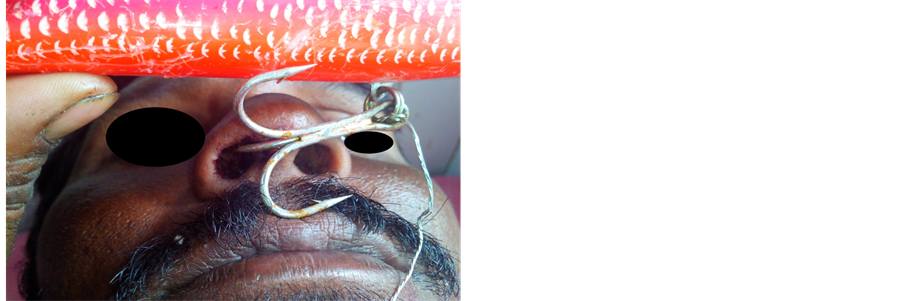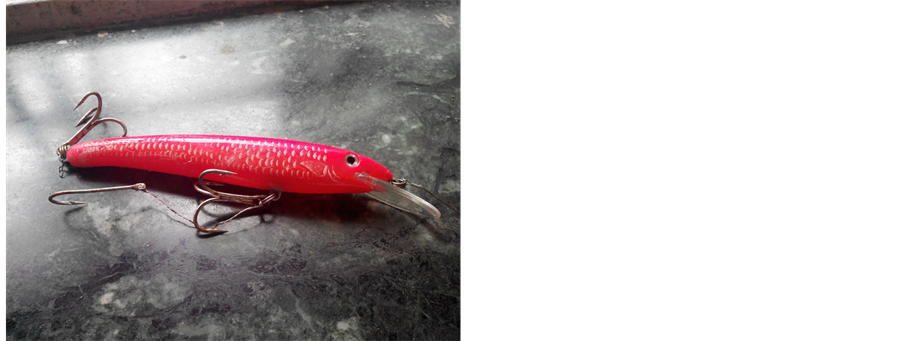1. Introduction
Nasal foreign bodies are one of the most common ENT emergencies encountered by otorhinolaryngologists & family physicians. Many types of unusual nasal foreign bodies are described in literature [1] -[3] . Some are easily managed as outpatient procedures while others need shifting the patient to operating room and removing them under sedation or general anaesthesia with instruments or endoscopes. Nasal foreign bodies like pea-nuts, erasers, thermocol balls, pearls, nasal rings are very common. But fish hook is a very rare foreign body. It has been reported in finger, foot or face of human being though more commonly in pet animals [4] -[6] . Fish hook in nose is a very tricky situation, and it is not described in world literature till date.
2. Case Report
A 30-year-old male fisherman presented to our emergency department with a fish hook entangled in his nose (Figure 1). While removing the fish hook from the mouth of a big fish, it suddenly got released and came towards his face which accidently entangled in his nose. He presented to our hospital with severe pain and bleeding from right nostril. On examination the fish hook was present in the right nostril, piercing the septum and tip of the hook was visible on left side of septum.
After adequate counselling a wire cutter was used to cut the pierced fishhook on its proximal end in right nostril with great care to prevent further damage of nostril or face by extra barbed ends of the treble fishhook. Then entangled hook was gently pushed at the proximal end on right nostril and later by pulling the tip with a needle holder in left nostril. Haemostasis was achieved. Patient was given tetanus toxoid injection, oral antibiotics, analgesics & antibiotic ointment for local application to prevent infection. Patient was reviewed after 7 days with no fresh complaints or complications.
3. Discussion
Fish hook (Figure 2) in nose is an extremely rare foreign body. There are no documented case reports in world literature till date. These are reported more commonly in veterinary practice [4] -[6] . Attempt to remove the fish hook by mere pulling will lead to severe pain, extensive tissue damage or severe bleeding due to peculiar arrangement of hook with post operative complication and significant morbidity to the patient. Improper removal of the fish hook can lead to septal haematoma, septal perforation, nasal deformity & synechiae formation leading to breathing difficulty. Children & uncooperative patients might have to be sedated so as to carry out the procedure smoothly. By cutting the proximal end near to the eye and pushing the hook will remove the hook easily & will lead to minimal complication. Otherwise pushing the hook through the exit wound until the barb is visible and remove the barb with a wire cutter or pliers and then pull the hook backwards, removing in the same way it went in. Local or topical anaesthesia with lignocaine and adrenaline may be used to reduce pain and bleeding. If bleeding persists it can be coagulated by cauterization or can be stopped by anterior nasal packing. As fish hook is a heavily contaminated object, tetanus toxoid [7] and antibiotics are to be prescribed to reduce the chance of infection.

Figure 1. Showing an entangled fish hook in the nose of the patient.

Figure 2. Showing a treble fish hook along with a single fish hook.
4. Conclusion
Penetrating fish hooks should be cut at the proximal end or at the barbed end and then only removed. Otherwise barbed end will harm further and will lead to complications.
Consent
N.B. Consent for taking photograph & printing/publishing it in electronic media/journals has been taken from the patient.